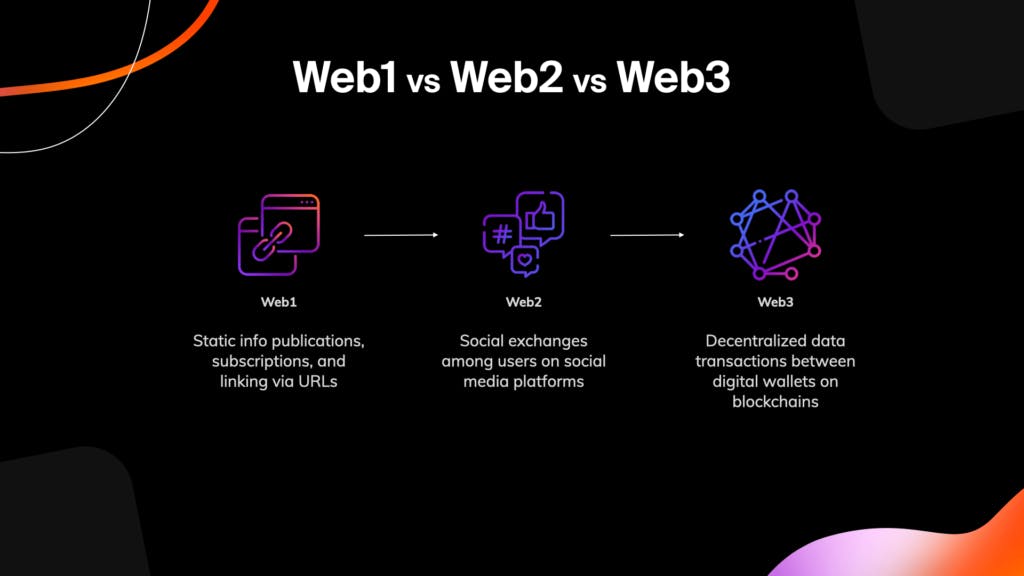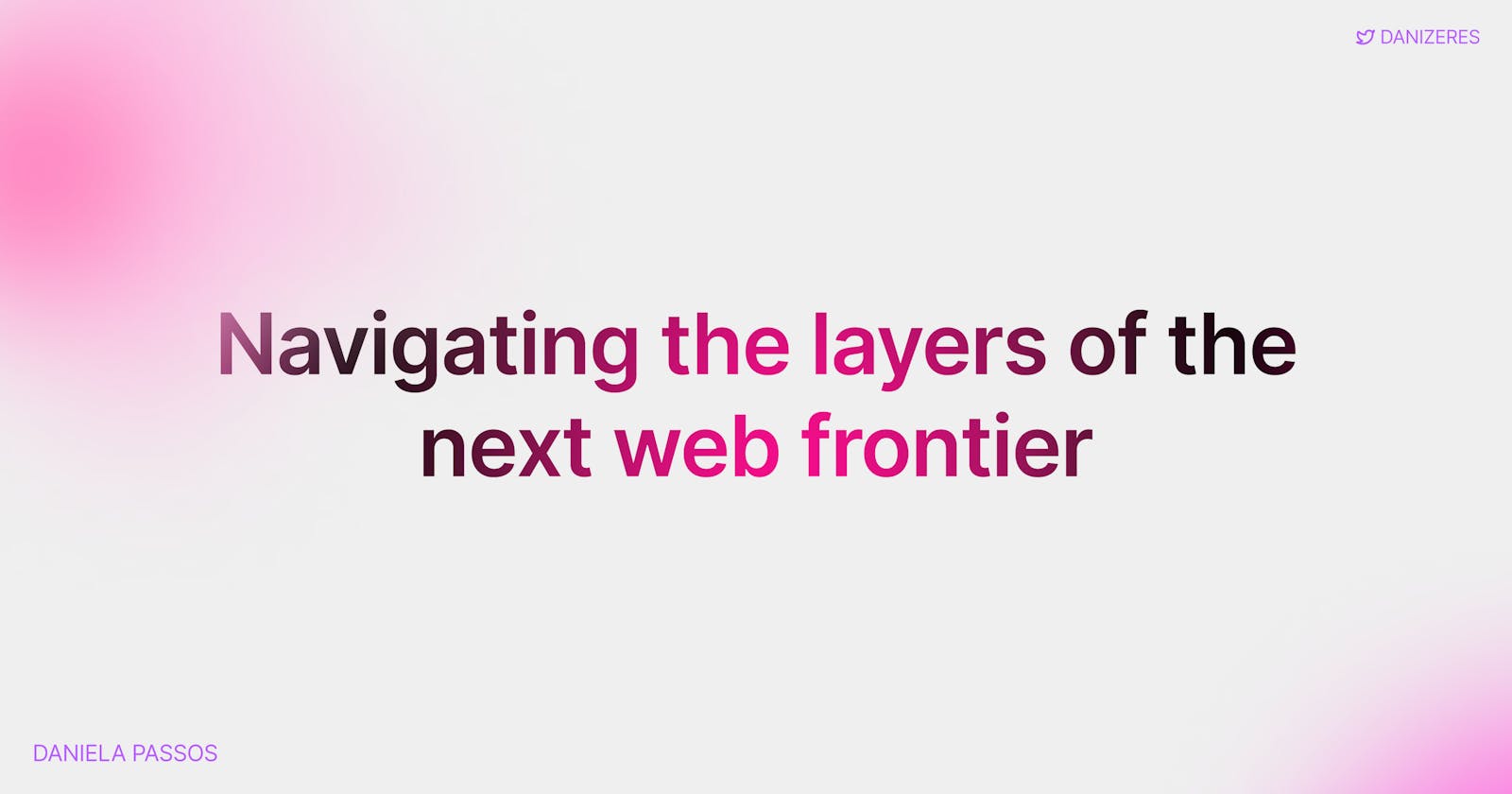If you've been around the tech block, you've probably heard of web3.
Before we deep dive, it's worth noting that this isn't just another iteration of the web. It's a paradigm shift, much like how the transition from static web pages (web1) to our current interactive web (web2) was. With web3, we're looking at a more democratized and decentralized future where the power dynamics of the internet are fundamentally reimagined.

An overview of web3
Web3 represents a decentralized internet. Unlike the current web (web2), where platforms own your data, in web3, you own your data. It offers a vision of a permissionless network, devoid of intermediaries, powered by blockchain. But what does it truly mean to be permissionless? At its core, it signifies a network where any participant can join and interact without seeking approvals from major platforms. It's an open invitation to build and create new interactions.
Yet, this freedom doesn't come at the cost of security. Web3 is designed to be robust and secure, leveraging cryptographic principles to ensure data integrity and user privacy.
Another fascinating aspect is 'composability'. Think of it as digital LEGO. In web3, different decentralized applications (dApps) can seamlessly interact and build upon each other, leading to exponential innovation and plug-and-play opportunities.
Layer 1: the foundation
Imagine building a house. Before you think about decor or furniture, you need a solid foundation. In the world of web3, Layer 1 (L1) is that foundation. It's the bedrock protocols like Ethereum and Bitcoin.
pragma solidity ^0.5.0;
contract HelloWorld {
string public greeting;
constructor() public {
greeting = 'Hello, World!';
}
function setGreeting(string memory _greeting) public {
greeting = _greeting;
}
function greet() view public returns(string memory) {
return greeting;
}
}
This simple smart contract on Ethereum showcases the power of L1 - setting immutable rules and functions that the entire network can trust.
Layer 2: the enhancements
Back to our house analogy. Once the foundation's set, you need electricity, plumbing - the systems that make a house livable. In web3, Layer 2 (L2) solutions are these systems. They build upon L1, offering scalability and faster transactions.
One popular L2 solution is Optimism, which uses a method called Optimistic Rollups.
def submit_tx_to_L2(tx_data):
if verify_tx(tx_data):
L2_chain.append(tx_data)
else:
raise Exception("Transaction invalid!")
def verify_tx(tx_data):
# This function checks the validity of the transaction
return tx_data in valid_txs
The pseudo-code above is a simple representation, but it captures the essence. L2 solutions, like Optimism, allow for transactions to be processed faster by assuming them to be valid by default, only verifying if challenged.
Let's simplify. Imagine you're at a cafe. Ordering a coffee is like initiating a transaction. In a crowded cafe (L1 during high congestion), your order might take time. Now, what if you had a special pass (L2) that lets you skip the line? Your coffee arrives faster, right? That's the promise of L2.
Gaming on the blockchain
Blockchain gaming has evolved past just the basic token transactions. The new era of play-to-earn games has reshaped the relationship between effort and reward. Players can now earn actual crypto assets that have real-world value, just by participating or excelling in a game. This kind of decentralized gaming economy stands in stark contrast to traditional gaming, where in-game purchases are often non-transferable and lose value outside of the game's ecosystem.
The challenge of scalability and user experience
However, as the adoption of blockchain games grows, so do the challenges. Traditional Layer 1 (L1) blockchains might be secure and decentralized, but they often lack the scalability required for the high transaction volumes seen in popular games. For instance, during high trading periods or when a new in-demand item drops, gamers can experience delays. These delays break the immersion and can turn away potential players. Furthermore, high gas fees on congested networks can make small transactions infeasible, limiting gameplay mechanics.
How Layer 2 solutions play a role in gaming
Layer 2 (L2) solutions provide the answer to these challenges. They handle transactions off the main chain, ensuring faster speeds without compromising on security. For example, when gamers trade virtual items, L2 processes the trade quickly, and only the final state is settled on the L1. This not only ensures smooth gameplay but also real-time trading without the deterrent of exorbitant gas fees. The ability to have thousands of transactions per second without clogging the main network makes blockchain gaming more viable and appealing to the broader audience, ensuring that the world of decentralized play-to-earn games continues to grow and evolve.
Real-world impact
The implications of integrating Layer 2 solutions into blockchain gaming are profound. Not only does it make the gaming experience smoother, but it also democratizes access. Gamers from regions with traditionally weaker currencies can earn assets that have a significant value conversion in their local currency. This isn't just gaming; it's an economic revolution, creating opportunities and bridging the global wealth gap, one game at a time.
Decentralized social media platforms
Democratizing content ownership
The rise of social media has revolutionized how we communicate, share, and consume information. But traditional platforms come with a caveat: they're centralized. This means that a single company or entity controls the data, often monetizing user information and content without sharing the profits with the actual creators. The centralization also leads to issues of censorship, content takedowns, and data privacy breaches.
Shift to decentralized platforms
Decentralized social media platforms aim to shift the balance of power back to the users. Built on blockchain technology, these platforms ensure true content ownership, where users have the keys to their data. On decentralized platforms, content, once published, is immutable. It can't be taken down by any centralized authority, ensuring freedom of speech and expression.
Digital identity and passports
The challenge of modern identity verification
In today's digital age, identity verification is paramount. From online banking to international travel, proving who you are is a necessity. Traditional systems, however, are fragmented, often prone to breaches, and can be a hassle to manage. Passports get lost, identity documents can be forged, and personal data can be hacked.
A secure foundation for identity
Enter blockchain. It offers a solution to these challenges by providing a tamper-proof, decentralized ledger where digital identities can be stored securely. Once an identity is verified and stored on the blockchain, it becomes a source of truth that can be accessed and verified without the need for physical documents.
Digital passports
Imagine having a digital passport, a blockchain-based representation of your identity. Not only would it be more secure (being immune to traditional forgery), but it would also be easily verifiable across borders. Customs and immigration could quickly check and validate your identity by accessing the blockchain, speeding up processes and reducing the chance of human error or bias.
Transforming identity management
Beyond just travel, a blockchain-based digital identity could revolutionize other sectors. From speeding up bank account verification processes to ensuring transparent voting in elections, the applications are vast. It's not just about convenience; it's about creating a more secure, efficient, and user-centric system for identity management in the modern world.
Owning your digital identity
In web3, you're not just a user; you're a stakeholder. Every tweet, post, or image can be a digital asset - an NFT (Non-Fungible Token).
Imagine writing a groundbreaking blog post and having it forever etched on the blockchain, verifiable as yours. That's the power of owning your content in web3.
The web3 revolution
The move to web3 isn't just technological; it's philosophical. It's about returning the internet to its users. As developers, we're not just spectators; we're pioneers. It's an exciting time to build, innovate, and shape the future.
So, whether you're deploying a smart contract on Ethereum, optimizing transactions with Optimism, or minting your first NFT, remember: you're crafting the future, one block at a time.
Let's connect on Twitter(X) and LinkedIn 👋

